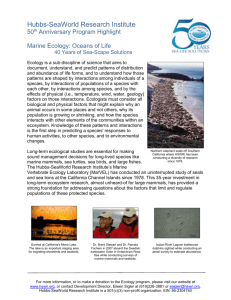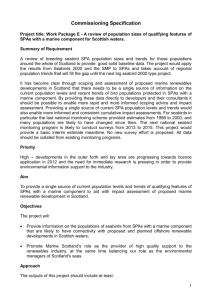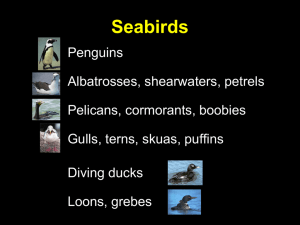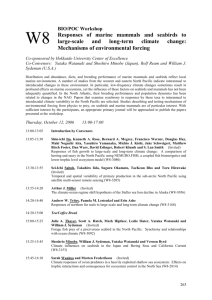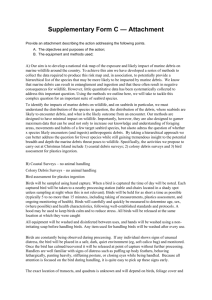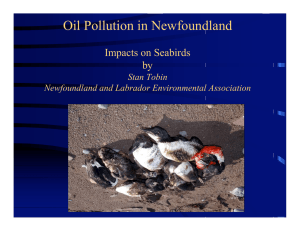Seabirds in the Marine Wilderness of the Western North Atlantic Falk Huettmann
advertisement
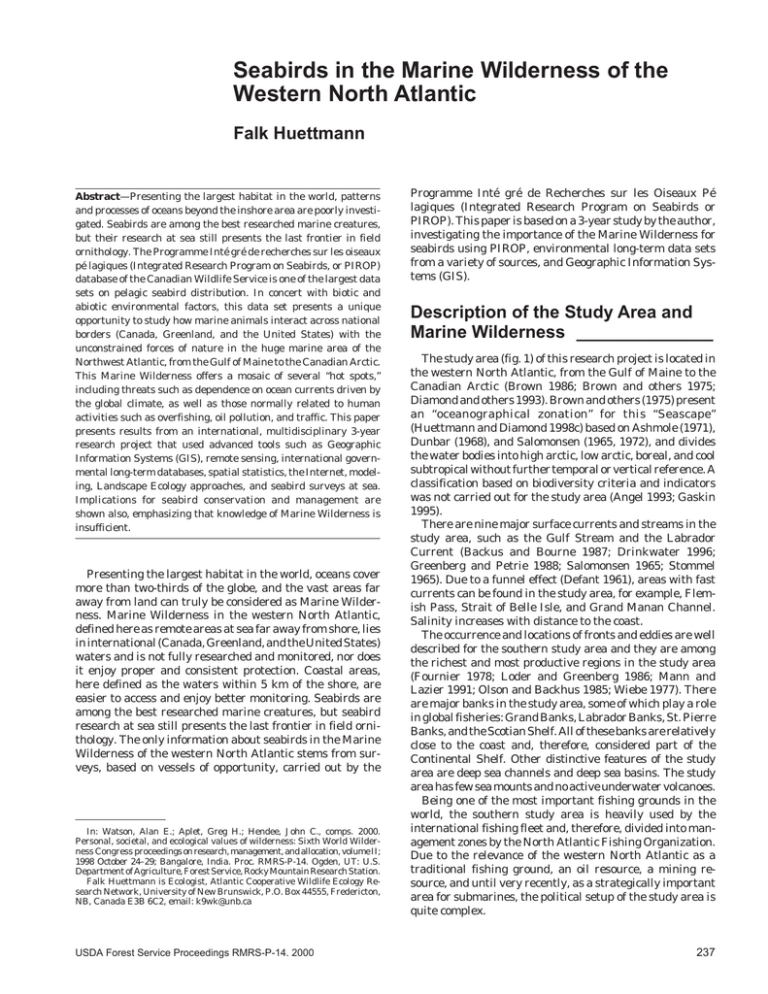
Seabirds in the Marine Wilderness of the Western North Atlantic Falk Huettmann Abstract—Presenting the largest habitat in the world, patterns and processes of oceans beyond the inshore area are poorly investigated. Seabirds are among the best researched marine creatures, but their research at sea still presents the last frontier in field ornithology. The Programme Inté gré de recherches sur les oiseaux pé lagiques (Integrated Research Program on Seabirds, or PIROP) database of the Canadian Wildlife Service is one of the largest data sets on pelagic seabird distribution. In concert with biotic and abiotic environmental factors, this data set presents a unique opportunity to study how marine animals interact across national borders (Canada, Greenland, and the United States) with the unconstrained forces of nature in the huge marine area of the Northwest Atlantic, from the Gulf of Maine to the Canadian Arctic. This Marine Wilderness offers a mosaic of several “hot spots,” including threats such as dependence on ocean currents driven by the global climate, as well as those normally related to human activities such as overfishing, oil pollution, and traffic. This paper presents results from an international, multidisciplinary 3-year research project that used advanced tools such as Geographic Information Systems (GIS), remote sensing, international governmental long-term databases, spatial statistics, the Internet, modeling, Landscape Ecology approaches, and seabird surveys at sea. Implications for seabird conservation and management are shown also, emphasizing that knowledge of Marine Wilderness is insufficient. Presenting the largest habitat in the world, oceans cover more than two-thirds of the globe, and the vast areas far away from land can truly be considered as Marine Wilderness. Marine Wilderness in the western North Atlantic, defined here as remote areas at sea far away from shore, lies in international (Canada, Greenland, and the United States) waters and is not fully researched and monitored, nor does it enjoy proper and consistent protection. Coastal areas, here defined as the waters within 5 km of the shore, are easier to access and enjoy better monitoring. Seabirds are among the best researched marine creatures, but seabird research at sea still presents the last frontier in field ornithology. The only information about seabirds in the Marine Wilderness of the western North Atlantic stems from surveys, based on vessels of opportunity, carried out by the In: Watson, Alan E.; Aplet, Greg H.; Hendee, John C., comps. 2000. Personal, societal, and ecological values of wilderness: Sixth World Wilderness Congress proceedings on research, management, and allocation, volume II; 1998 October 24–29; Bangalore, India. Proc. RMRS-P-14. Ogden, UT: U.S. Department of Agriculture, Forest Service, Rocky Mountain Research Station. Falk Huettmann is Ecologist, Atlantic Cooperative Wildlife Ecology Research Network, University of New Brunswick, P.O. Box 44555, Fredericton, NB, Canada E3B 6C2, email: k9wk@unb.ca USDA Forest Service Proceedings RMRS-P-14. 2000 Programme Inté gré de Recherches sur les Oiseaux Pé lagiques (Integrated Research Program on Seabirds or PIROP). This paper is based on a 3-year study by the author, investigating the importance of the Marine Wilderness for seabirds using PIROP, environmental long-term data sets from a variety of sources, and Geographic Information Systems (GIS). Description of the Study Area and Marine Wilderness ______________ The study area (fig. 1) of this research project is located in the western North Atlantic, from the Gulf of Maine to the Canadian Arctic (Brown 1986; Brown and others 1975; Diamond and others 1993). Brown and others (1975) present an “oceanographical zonation” for this “Seascape” (Huettmann and Diamond 1998c) based on Ashmole (1971), Dunbar (1968), and Salomonsen (1965, 1972), and divides the water bodies into high arctic, low arctic, boreal, and cool subtropical without further temporal or vertical reference. A classification based on biodiversity criteria and indicators was not carried out for the study area (Angel 1993; Gaskin 1995). There are nine major surface currents and streams in the study area, such as the Gulf Stream and the Labrador Current (Backus and Bourne 1987; Drinkwater 1996; Greenberg and Petrie 1988; Salomonsen 1965; Stommel 1965). Due to a funnel effect (Defant 1961), areas with fast currents can be found in the study area, for example, Flemish Pass, Strait of Belle Isle, and Grand Manan Channel. Salinity increases with distance to the coast. The occurrence and locations of fronts and eddies are well described for the southern study area and they are among the richest and most productive regions in the study area (Fournier 1978; Loder and Greenberg 1986; Mann and Lazier 1991; Olson and Backhus 1985; Wiebe 1977). There are major banks in the study area, some of which play a role in global fisheries: Grand Banks, Labrador Banks, St. Pierre Banks, and the Scotian Shelf. All of these banks are relatively close to the coast and, therefore, considered part of the Continental Shelf. Other distinctive features of the study area are deep sea channels and deep sea basins. The study area has few sea mounts and no active underwater volcanoes. Being one of the most important fishing grounds in the world, the southern study area is heavily used by the international fishing fleet and, therefore, divided into management zones by the North Atlantic Fishing Organization. Due to the relevance of the western North Atlantic as a traditional fishing ground, an oil resource, a mining resource, and until very recently, as a strategically important area for submarines, the political setup of the study area is quite complex. 237 Figure 1—Map showing locations of observed seabirds in PIROP, 1967-1992, and the seabird species richness for the study area. Agnew (1993) discusses the Davis Strait/Labrador Sea as one of three regions with high sea ice and atmospheric variability. The region from the Middle Atlantic Bight to the Grand Banks exhibits the highest inter-annual variability of sea surface temperature anywhere in the North Atlantic Ocean (Cayan 1986 in Petrie and Drinkwater 1993; Drinkwater 1996; Petrie and others 1992). One reason for this variability is the connection of the study area with the global climate and global seas. However, the biologically important Cold Intermediate Layer is relatively stable. One of the biggest environmental changes in this marine ecosystem, a near surface event known as the “Great Salinity Anomaly,” occurred throughout the southern study area from approximately 1969 to 1972 (Angel 1993; Mertz and Myers 1994). Furthermore, Mann and Drinkwater (1994) and Drinkwater (1996) described the North Atlantic Oscillation (NAO) and big variations of the NAO Index occurring from 1900 to 1986. Severe and overall changes can be expected for the study area in the event of global warming (Mann and Lazier 1991; Montevecchi and Myers 1997). In particular, the southern section of the study area is threatened by overfishing (Backus and Bourne 1987; Wilson and Addison 1984 for Gulf of Maine) (do Carmo Gomes 1993; Harris 1998 for Grand Banks) and contamination by radionuclides, chemical and thermal effluents from the Point Lepreau Nuclear Power Plant (Nelson and others 1998). It is also threatened by industrial sources, heavy metals, and sea floor contamination in the Bay of Fundy/Gulf of Maine 238 (Backus and Bourne 1987; Braune 1987; Braune and Gaskin 1987; Gaskin 1987; Loring 1981, 1982). The biggest threats, oil exploration and the transportation of oil and cargo, can be found in the southern highly populated areas (Backus and Bourne 1987; Nettleship 1997). Traffic already accounts for considerable mortality to endangered North Atlantic right whales (Eubalaena glacialis) (Brown and others 1995; Gaskin 1987) and poses significant threats of oil spills to wintering auk populations (Green and Hirons 1993; Lock and others 1994). The arctic regions have not been fully investigated for threats or for their potential as protected areas (Beckmann 1995). Although the need for protected areas at sea has been emphasized by a variety of researchers and agencies (Nettleship 1997; Shackell and Willison 1995), there are no regions at sea within the study area that have any true, yearround protection status. Data Sets ______________________ Integrated Research Program on Seabirds Initiated by the Canadian Wildlife Service in 1966 for monitoring seabirds at sea, the Integrated Research Program on Seabirds (PIROP) database originally consisted of vessel-based 10-minute seabird counts in the western North Atlantic (Brown 1986; Brown and others 1975; Lock and USDA Forest Service Proceedings RMRS-P-14. 2000 others 1994). This program also includes aerial survey data and a large amount of occasional observations of sea mammals and birds other than seabirds, such as waterfowl and passerines (Lock and others 1994). The PIROP database is fully digitized (dBASE, relational database) and includes software for analytical GIS work and convenient data entry (Huettmann and Lock 1997). It was recently extended with the addition of the U.S. Manomet Seabird data for the Gulf of Maine area (Powers and others 1979). With 26 years (1966 to 1992) of seabird-at-sea observations, PIROP is the largest data set on this topic (Diamond and others 1993; Lock and others 1994) and is available for the scientific community. Environmental Data Sets For this study, 20 environmental data layers were used for GIS overlays in combination with PIROP within the study area (table 1) (Huettmann 1997a). All data sets used are available for the scientific community free of charge and were derived from satellite images, and official oceanographic, meteorological, and governmental data sources. Data transfer was accomplished via the Internet (ftp, WWW, and email) or sometimes digital media (floppy disks, zip disks, and CD-ROMs); the Internet option proved to be the best, most convenient way to locate, present, and transfer/ download data and subsets from large public databases across platforms. Table1—Overview of the data sets used to investigate Seabirds in the Marine Wilderness. No. Name of data set Seabirds 1 PIROP Atmospherical 2 Atmospheric temperature at 880 mbar 3 Standard temperature atmospheric at 880 mbar 4 Wind speed 5 Air pressure at sea level 6 Air temperature 7 Wind when seabird observation was done Geographical 8 Sea depth 9 Slope of sea floor 10 Aspect of sea floor 11 Distance from coast 12 Distance from a seamount Water 13 Sea surface temperature 14 Water temperature at 30 m depth 15 Sea surface salinity 16 Water salinity at 30 m depth 17 Salinity difference surface - 30 m depth 18 Temperature difference surface - 30 m depth 19 Sea state when seabird observations were done Additional Data Sets 20 ECNASAP groundfish 21 Seabird colonies Data source Data type Units Bedford Institute for Oceanography, Environment Canada, Canadian Wildlife Service, Manomet Bird Observatory Continuous Seabirds within a 10-minute block 1966-1992 Pathfinder (NOAA) Continuous Kelvin April 1987December 1988 Pathfinder (NOAA) Continuous Standard deviation April 1987December 1988 COADS (NOAA) COADS (NOAA) Continuous Continuous Meter/second Mbar 1854-1993 1854-1993 COADS (NOAA) PIROP Continuous Discrete Kelvin Classified 1854-1993 1966-1992 ETOPO5 SPANS-GIS from ETOPO5 SPANS-GIS from ETOPO5 SPANS-GIS SPANS-GIS from ETOPO5 Continuous Continuous Discrete Discrete Discrete Meters Degrees Classified Distance bands Distance bands 1988 1988 1988 1998 1996 WOA (NOAA) Continuous Degrees Celsius 1948-1988 WOA (NOAA) Continuous Degrees Celsius 1948-1988 WOA (NOAA) WOA (NOAA) Continuous Continuous Parts per million Parts per million 1948-1988 1948-1988 SPANS-GIS based on WOA (NOAA) Continuous Parts per million 1948-1988 SPANS-GIS based on WOA (NOAA) Continuous Degrees Celsius 1948-1988 PIROP Discrete Classified 1966-1992 Department of Fisheries and Oceans, Dartmouth Lock and others 1994, Cairns 1989 Continuous KG biomass, species richness Breeding pairs 1970-1994 USDA Forest Service Proceedings RMRS-P-14. 2000 Continuous Time cover 1989, 1994 239 Seabirds in Summer _____________ Migration ______________________ The distribution of seabirds at sea is most easily monitored in summer, due to relatively mild weather conditions and ongoing colony-based research. Most of the seabird colony locations in the study area are well known (Boertmann and others 1996; Cairns and others 1989; Nettleship 1980). However, systematic sampling of the huge oceanic ecosystem is rarely attempted, and opportunistic sampling, such as PIROP, is the source of most information (Brown 1986). The temporal extent and timing of the breeding season for seabirds in the study area is mostly a function of latitude; Diamond and others (1993) define a northern and a southern breeding regime (borderline at approximately 52o N). During the summer, breeding seabirds are attached to their breeding colonies due to the need for providing their chicks with food (Huettmann and Diamond 1997b; Weimerskirch 1998). Most of the seabird species in the Canadian North Atlantic have up to 40 percent nonbreeders in their population (Diamond and others 1993), which could theoretically be found dispersed all over the Atlantic because they are not constrained in their movements by the duty to provide for their chicks. Breeding in the southern hemisphere, Wilson’s storm petrels (Oceanites oceanicus) as well as greater (Puffinus gravis) and sooty shearwaters (P. griseus) are the only seabird species that occur in great numbers in the study area without actually breeding there. All seabirds in the North Atlantic migrate. Normally, their migration covers many hundreds of kilometers and is affected by foraging, breeding, molting, flight energetics, and the travel between winter and summer grounds (Furness and Burger 1988; Newton and Dale 1996; Pennycuick 1987). The importance of the Marine Wilderness for migration, for resting areas, and as a flyway for North Atlantic seabirds is not well known; these topics are difficult to investigate in the field, and most knowledge consists of rough descriptions and arrows on maps (Braune 1987; Furness 1987; Powers 1983; Tuck 1961). The only quantitative information on seasonal seabird migration stems normally from recoveries of birds banded in colonies during summer (Brewer and others, in preparation) or, to a lesser degree, from terrestrial and atsea observations (Stenhouse and Montevecchi 1996). Satellite transmitters offer the best data on movement patterns, but to date have been applied to larger seabirds only and not in the area covered by PIROP (Prince and others 1992). Seabirds in Winter _______________ Research about seabirds at sea presents “the last frontier in field biology” (Brown 1981 in Thurston 1990). The importance of this statement can be shown by the marginal scientific knowledge about seabird distribution during winter months (November through February) in the offshore region of the North Atlantic (Brown 1986; Nettleship and Birkhead 1985; Powers and others 1979). Significant seabird information for this time of the year (for example, their distribution within the Marine Wilderness) is scarce (Gaston and McLaren 1990; Huettmann and others, in preparation). So far, it is believed that most pelagic seabird populations, such as thick-billed murres (Uria lomvia) and Atlantic puffins (Fratercula arctica), simply disperse in winter over the vast Northern Atlantic (Nettleship and Birkhead 1985). The small amount of existing information for this time of the year includes some feeding studies (Elliot and others 1990; Falk and Durinck 1993) and movement patterns (Donaldson and others 1997) derived from work in Greenland, the “Turr” (mostly thick-billed murres and common murres Uria aalge that hunt off Newfoundland), polynyas (Brown and Nettleship 1981), and ice cover (Orr and Parsons 1982). Large data gaps for winter also exist in PIROP. Therefore, transferring knowledge derived from seabirds found in comparable areas elsewhere offers perhaps the only way to learn more on how seabirds cope with winter in the Marine Wilderness (see Divoky 1979 for the Pacific) (see Ainley and others 1993; Hunt and Nettleship 1988 for the Antarctic) (see Durinck and Falk 1996; Joiris 1983 for the North Atlantic). 240 Methods _______________________ For analyzing seabird distribution during winter and breeding season, the PIROP database was queried with FoxPro (Siegel 1995) for the particular months. Only seabird species that had sufficient observations were included; resulting data were then imported and visualized in a GIS format. I am using SPANS-GIS (Huettmann 1998; Huettmann and Diamond 1998a; INTERAC TYDAC 1995) to present bird observations in the study area, to create surfaces for environmental data layers (Huettmann 1998), and to overlay different data layers per month (Huettmann 1997a) for further statistical analysis in SPLUS (StatSci 1995). Logistic regression and Classification and Regression Trees were used to test for significant results (StatSci 1995). Seabird queries for the environmental data overlays were filtered for “standardized seabird counts” following Tasker and others (1984). To track seabird movements during the year, locations of observed juveniles and molting seabirds in PIROP were queried and then analyzed per month in SPANSGIS. Results and Discussion __________ Seabirds in Summer Due to their limited feeding range, breeding seabirds in the study area show a very coastal distribution concentrated around their seabird colonies (Huettmann and Diamond 1998b). For most of the breeding seabirds, such as northern gannet (Sula bassanus), black-legged kittiwake (Rissa tridactyla), northern fulmar (Fulmarus glacialis), herring gull (Larus argentatus), great black-backed gull (L. marinus), Iceland gull (L. glaucoides), glaucous gull (L. hyperboreus), thick-billed murre, common murre and Atlantic puffin, high concentrations occur on the west and north shores of the St. Lawrence region, Labrador coast, east Newfoundland coast, USDA Forest Service Proceedings RMRS-P-14. 2000 northern Hudson Bay, West Greenland, and the Canadian High Arctic. These are areas that are normally free of ice in the pre-breeding season (Huettmann and Diamond 1998a). For seabird species included in the investigation of the environmental data overlay with PIROP for the breeding season (black-legged kittiwake, common murre, thick-billed murre, northern fulmar, Atlantic puffin, northern gannet), results show a complex situation with several factors determining their distribution and colony locations. However, depth, distance to coast, sea floor aspect, and meteorological parameters such as sea level pressure, wind speed, and air temperature are significant factors for the seabird distribution in summer. Nonbreeding birds were observed either close to these colonies (most likely in order to obtain mates for breeding and to occupy potential breeding sites) or far away from any colonies. We assume that the latter birds are normally young individuals that disperse from their original colonies to look for potential mates elsewhere or to feed opportunistically in areas where food is plentiful and easily accessed. During the breeding season, northern fulmars (likely nonbreeding individuals from the whole northern Atlantic) can be found on the Labrador Shelf (Hatch and Nettleship 1998). Baird (1994) presents that the Grand Banks are of international importance for black-legged kittiwakes year round. Nonbreeding northern gannets were observed in the Grand Manan region. Our data show an abundance of greater shearwaters in the southern study area from mid-May through July (breeders) and June through November (nonbreeders) carrying out a trans-equatorial migration from the southern hemisphere for molting (Brown 1988). During summer, the Marine Wilderness is not used by most seabirds to the same extent as the coastal zones. Even nonbreeding birds, with the ability to range freely, were most often found in offshore regions of the Continental Shelf. Seabirds in Winter Environmental data suggest that the winter season must be divided into early (November and December) and late winter (January and February). The Davis Strait is still open in early winter but is covered with sea ice in December, driving most arctic birds into southern waters such as the Labrador Sea, Grand Banks, Scotian Shelf, and Gulf of Maine. This is also supported by observations indicating that the marine environment changes substantially from the early winter season to the late winter season (Braune 1987 for early winter plankton peak in the Bay of Fundy; Elliot and others 1990 for shift of seabird prey). The environmental data overlays with seabirds in PIROP for the winter season were done for the following species: black-legged kittiwake, dovekie (Alle alle), northern fulmar, great black-backed gull, herring gull, white gulls (Iceland gull, glaucous gull, ivory gull Pagophila eburnea, Ross’s gull Rhodostethia rosea), and large auks (thick-billed murre, common murre, Atlantic puffin, razorbill Alca torda). Results show that mostly sea floor aspect, distance to coast, and the classical oceanographical factors such as water temperature, salinity, and wind speed determine seabird distribution in winter. The data clearly indicate a pelagic distribution for northern fulmars and black-legged kittiwakes. Great USDA Forest Service Proceedings RMRS-P-14. 2000 black-backed gulls and herring gulls were found offshore, but are mainly coastal (Root 1988). Large auks were observed offshore, but the winter hunt on “Turrs” and, in particular, findings from winter surveys off Grand Manan for wintering razorbills indicate a very high density of wintering birds in inshore (less than approximately 5 km from land) coastal waters (Huettmann and others, in preparation; Root 1988). Root (1988) indicated that the Grand Manan and Passamaquoddy Bay area also hosts the largest numbers of black-legged kittiwakes observed during Christmas bird counts on the North American continent. Iceland gulls were mostly found in coastal areas southwest of Newfoundland, Cape Breton, south of Nova Scotia, and around the Magdalen Islands. Root (1988) reports that observations of Iceland gulls were high at the extreme southeastern point of New Brunswick. In terms of their distribution, Iceland gulls can, therefore, be labeled as coastal birds in winter. These results suggest that, in terms of numbers and concentrations of seabirds occurring in the study area during winter, the coastal waters may be more important than suggested earlier, at least for the southern study area such as the Bay of Fundy, southern Nova Scotia, and the Gulf of Maine. Ice-free coastal zones in the study area present an important wintering ground for most seabird species, where they share their habitat with other waterbirds, such as waterfowl, grebes, and loons (Root 1988). I conclude that coastal zones must present a richer habitat for seabirds in winter than the ice-free Marine Wilderness far offshore. Post and Pre-Breeding Migration Seabird migration can be characterized as a directed movement between summer and winter grounds. Although migration strategies for seabirds are not that well researched, at least some resting grounds during migration are roughly known. My results indicate that juvenile thick-billed murres do not show a rapid southward movement after leaving the colonies. Their migration flyway seems to follow the coastline and shelf edges, instead of crossing the open sea directly (except for the Davis Strait off the Cumberland Peninsula). Most of the northern gannets leave the breeding colonies in the St. Lawrence estuary and off Newfoundland completely by September, and then return in mid-April. Greater shearwaters arrive in the study area beginning in mid-May, followed by juvenile birds during the next months. They can be found in the coastal waters off southern Newfoundland feeding on capelin (Mallotus villosus) and have been observed dispersing as far north as Greenland. After July, they make full use of the whole North Atlantic. Breeding birds seem to leave the study area starting in July; remaining birds, likely nonbreeders, can be found in the area until December. Northern fulmars were observed in the study area year-round. Hatch and Nettleship (1998) indicate that birds in North America generally do not show a directed movement, except perhaps birds from the High Arctic. However, due to the presence in the study area of birds from the whole North Atlantic, movement patterns can be detected from changing numbers on the banks. Black-legged kittiwakes were found all over the study area, with high densities in the Gulf of Maine region in winter. Herring gulls show a clear removal from the St. Lawrence area during 241 winter and a southward movement for wintering to the Gulf of Maine and beyond. Great black-backed gulls exhibit the same wintering pattern as herring gulls, but breed farther north. Iceland gulls move between winter and summer grounds along the coastal shelf edge and ice edge. Glaucous gull movements indicate a more pelagic wandering than Iceland gulls. General The distribution and biology of seabirds that are rare, difficult to determine, and hard to see or count at sea still presents a challenge, and their conservation status and biology remain unknown in the study area. Jaegers (Stercocarius parasiticus, S. pomarinus, S. longicaudus), and Cory (P. diomedea) and Manx’s shearwaters (P. puffinus) occur in the study area, but even basic biological knowledge is lacking. The world’s largest known nesting colony of Leach’s storm-petrels (Oceanodroma leucorhoa) can be found in the study area on Baccalieu Island on the Grand Banks (Sklepkovych and Montevecchi 1989), but their feeding grounds, wintering grounds, and movement patterns are not known. Schneider and Heinemann (1996) indicate the importance of the southern study area for two other seabird species from the southern hemisphere (Wilson storm petrel and sooty shearwater), but details on distribution, population, and biology for these species are only conjecture. Conclusion _____________________ The importance of the Marine Wilderness for seabirds is not known nor fully monitored. The results, so far, indicate that coastal areas, and to a lesser degree the Continental Shelf, are key zones for seabirds during the winter (such as the Bay of Fundy, southern Nova Scotia, and the Gulf of Maine) and during the breeding season (almost the entire coastline of the study area) (see fig. 1). The shelf edge is used by most seabirds for activities such as feeding, migrating, or roosting (nonbreeders). For the study area, I conclude that the Marine Wilderness presents a relatively poor and homogenous environment for seabirds (see also Dunbar 1968 for the arctic; Wiebe 1977 for mosaics in boreal waters) where environmental conditions can be extreme and prey is difficult to catch. Shallow but remote areas at sea, such as the extending Continental Shelf, are used by truly pelagic seabird species, such as black-legged kittiwakes and northern fulmars, and for a relatively short period of time by greater shearwaters, herring gulls, and great black-backed gulls. Besides other basic biological parameters in winter, habitat use of the Marine Wilderness is not fully known for the Atlantic puffin, thick-billed and common murre, jaegers, manx and Cory’s shearwater, and Leach and Wilson’s storm petrel. During the migration season, deep-water sections of the Marine Wilderness are used by seabirds like the glaucous gull, Iceland gull, and great black-backed gull to connect winter and summer grounds. I recommend that a specially designed, interdisciplinary seabird survey program be conducted for the Marine Wilderness (with consideration of the area’s international nature) to learn more about this huge and important habitat. 242 References _____________________ Agnew, D. 1993. Simultaneous winter sea-ice and atmospheric circulation anomaly patterns. Atmosphere-Ocean. 31(2): 259-280. Ainley, D. G.; Ribic, C. A.; Spear, L. B. 1993. Species-habitat relationships among antarctic seabirds: a function of physical or biological factors? The Condor. 95: 806-816. Angel, M. V. 1993. Biodiversity in the pelagic ocean. Conservation Biology. 4(4): 760-772. Ashmole, N. P. 1971. Seabird ecology and the marine environment. In: Farner, D. S.; King, J. R., eds. Avian Biology. New York, NY: Academic Press: 223-286. Backus, R. H.; Bourne, D. W. 1987. The Georges Bank. Woods Hole, MA: MIT Press. 593 p. Baird P. 1994. Black-legged kittiwake (Rissa tridactyla). In: Poole, A.; Gill, F., eds. The birds of North America, No. 92. Philadelphia, PA: The Birds of North America Inc. 27 p. Beckmann, L. 1995. Marine conservation in the Canadian Arctic. In: Shackell, N.; Willison, J. H. M., eds. Marine protected areas and sustainable fisheries. Science and Management of Protected Areas Association. Wolfville, Nova Scotia: 227-235. Boertmann, D.; Mosbech, A.; Falk, K.; Kampp, K. 1996. Seabird o o colonies in western Greenland (60 -79 30' N. lat.), NERI Tech. Rep. 170. Roskilde, Denmark: National Environmental Research Institute. 148 p. Braune, B. M. 1987. Seasonal aspects of the diet of Bonaparte’s gulls (Larus philadelphia) in the Quoddy region, New Brunswick, Canada. The Auk. 104: 167-172. Braune, B. M.; Gaskin D. E. 1987. Total mercury levels in Bonaparte gulls (Larus philadelphia) during autumn molt in the Quoddy region, Brunswick, Canada. Archive of Environmental Contamination and Toxicology. 16: 539-549. Brewer, D.; Diamond T.; Woodsworth, E. [In preparation]. Canadian bird banding atlas. Ottawa, ON, Canada: Canadian Wildlife Service. Brown, R. G. B. 1986. Revised atlas of Eastern Canadian seabirds. Ottawa, ON, Canada: Canadian Wildlife Service. 110 p. Brown, R. G. B. 1988. The Wing-molt of fulmars and shearwaters (Procellariidae) in Canadian Atlantic waters. The Canadian Field-Naturalist. 102(2): 203-208. Brown, R. G. B.; Nettleship, D. 1981. The biological significance of polynyas to arctic colonial seabirds. In: Stirling, I.; Cleator, H., eds. Polynyas in the Canadian Arctic. Occasional Paper Number. Ottawa, ON, Canada: Canadian Wildlife Service: 59-65. Brown, R. G. B.; Nettleship, D. N.; Germain, P.; Tull, C. E.; Davis, T. 1975. Atlas of eastern Canadian seabirds. Ottawa, ON, Canada: Canadian Wildlife Service. 219 p. Brown, M.; Allen, J. M.; Kraus S. 1995. The designation of seasonal Right Whale Conservation Areas in the waters of Atlantic Canada. In: Shackell N.; Willison, J. H. M., eds. Marine Protected Areas and sustainable fisheries. Wolfville, NS, Canada: Science and Management of Protected Areas Association: 82-90. Cairns, D. K.; Montevecchi, W. A.; Threlfall, W. 1989. Researcher’s guide to Newfoundland seabird colonies. Occasional Papers in Biology, No.14. St. John’s, NF, Canada: Memorial University of Newfoundland. 34 p. Defant, A. 1961. Physical oceanography. Vol I. Oxford, UK: Pergamon Press. 729 p. Diamond, A. W.; Gaston, A. J.; Brown, R. G. B. 1993. Studies of highlatitude seabirds. 3. A model of the energy demands of the seabirds of eastern Arctic Canada. In: Montevecchi, W. A., ed. Canadian Wildlife Service Occasional Paper No. 77. Ottawa, ON, Canada. 39 p. Divoky, G. J. 1979. Sea ice as factor in seabird distribution and ecology in the Beaufort, Chukchi and Bering Seas. In: Bartonek, J. C.; Nettleship, D. N., eds. Conservation of marine birds of northern North America. Washington, DC: U.S. Department of the Interior, Fish and Wildlife Service: 9-17. do Carmo Gomes, M. 1993. Predictions under uncertainty. St.John’s, Newfoundland: Institute of Social and Economic Research. 240 p. Donaldson, G. M.; Gaston, A. J.; Chardine J. W.; Kampp, K.; Nettleship, D. N.; Elliot, R. D. 1997. Winter distributions of thickbilled murres from the eastern Canadian Arctic and western Greenland in relation to age and time of year. Occasional Paper Number 96. Ottawa, ON: Canadian Wildlife Service. 26 p. USDA Forest Service Proceedings RMRS-P-14. 2000 Drinkwater, K. F. 1996. Atmospheric and oceanic variability in the northwest Atlantic during the 1980’s and early 1990’s. Journal of Northwest Atlantic Fisheries Science. 18: 77-97. Dunbar, M. J. 1968. Ecological developments in polar regions: a study in evolution. Englewood Cliffs, NJ: Prentice-Hall. 119 p. Durinck, J.; Falk, K. 1996. The distribution and abundance of seabirds off southwestern Greenland in autumn and winter 19881989. Polar Research. 15(1): 23-42. Elliot, R. D.; Ryan, P. C.; Lidster, W. W. 1990. The winter diet of thick-billed murres in coastal Newfoundland waters. Studies in Avian Biology. 14: 125-138. Falk, K.; Durinck, J. 1993. The winter diet of thick-billed murres, Uria lomvia, in western Greenland, 1988-1989. Canadian Journal of Zoology. 71: 264-272. Fournier, R. O. 1978. Biological aspects of the Nova Scotia shelfbreak fronts. In: Bowman, M. J.; Esaias, W. E., eds. Oceanic fronts in coastal processes. Marine Sciences Research Center. New Orleans, LA: Springer Verlag: 22-35. Furness, R. W. 1987. The skuas. Calton, UK: T. & A. D. Poyser. 363 p. Furness, R. W.; Burger, A. E. 1988. Effects of energy constraints on seabird breeding at high latitudes. In: Quellet, H., ed. Proceedings XIX International Ornithological Congress 1986. Ontario, Canada: University of Ottawa Press: 1205-1217. Gaskin, D. E. 1987. Updated status of the right whale, Eubalaena glacialis, in Canada. Canadian Field-Naturalist. 101(2): 295-309. Gaskin, D. E. 1995. Marine biodiversity monitoring. Department of Zoology, University of Guelph, Ontario. 120 p. Gaston, A. J.; McLaren, P. L. 1990. Winter observations of black guillemots in Hudson Bay and Davis Strait. Studies in Avian Biology. 14: 67-70. Green, R. E.; Hirons, G. J. M. 1993. The relevance of population studies to the conservation of threatened birds. In: Perrins, C. M.; Lebreton, J. D.; Herons, G. J. M., eds. 1993. Bird population studies: relevance to conservation and management. Oxford University Press, UK: 594-637. Greenberg, D. A.; Petrie, G. D. 1988. The mean barotropic circulation on the Newfoundland Shelf and Slope. Journal of Geophysical Research. 93(C12): 15,541-15,550. Harris, M. 1998. Lament for an ocean. Toronto, Ontario: McClelland & Stewart. 342 p. Hatch, S. A.; Nettleship, D. N. 1998. Northern fulmar (Fulmarus glacialis). In: Poole, A.; Gill, E., eds. The birds of North America, Vol. 361. Philadelphia, PA: The Birds of North America, Inc. 32 p. Huettmann, F. 1997a. Birds at sea: linking long-term monitoring data for seabirds with oceanographic data. In: The ecological monitoring and assessment network report on the third national science meeting: proceedings; 1997 January 21-25; Saskatoon, Saskatchewan, Canada: 54-57. [Online] EMAN website: http:// www.cciw.ca/eman-temp/reports/publications/nm97_birds/ intro.html. Huettmann, F. 1997b. [Personal communication]. Selected issues for the successful application of a Geographic Information System in ornithology: some considerations for working with georeferenced data. GIS Workshop for the Society of Canadian Ornithologists; 7-10 August 1997; Peterborough, ON, Canada. Huettmann, F. 1998. An ecological GIS research application for the Northern Atlantic—The PIROP database software, environmental data sets and the role of the Internet/WWW. In: Riekert, W.F.; Tochtermann K., eds. “Hypermedia im Umweltschutz” Proceedings of Deutsche Gesellschaft fü r Informatik (GI) and Forschungsinstitut fü r anwendungsorientierte Wissensverarbeitung (FAW) Ulm. Umwelt-Informatik aktuell; Bd.17, Metropolis Verlag/Marburg: 213-217. Huettmann, F.; Diamond, A. W. 1998a. Seabird surveys and selected environmental data sets in the Bay of Fundy: findings and conclusions from monthly ferry transects (St. John-Digby-St. John). Proceedings of EMAN 97 Conference Bay of Fundy; 1997 November; St.Andrews, New Brunswick: 85-92. Huettmann, F.; Diamond, A. W. 1998b. Characterizing, modeling and predicting locations of seabird colonies in the Davis Strait: using the PIROP database, GIS and environmental data to evaluate the suitability of marine breeding habitats for Arctic seabirds. Proceedings of environmental prediction workshop; 1998 February 17-19; Halifax, NS. Environment Canada: 86-94. USDA Forest Service Proceedings RMRS-P-14. 2000 Huettmann, F.; Diamond, A. W. 1998c. “Seascape” ecology: applying terrestrial concepts of marine systems. Poster at the International Association for Landscape Ecology Conference; 1998 March 17-21; East Lansing, MI. Huettmann, F.; Lock, A. R. 1997. A new software system for the PIROP database: data flow and an approach for a seabird-depth analysis. International Council for the Exploration of the Sea. Journal of Marine Science. 54: 518-523. Huettmann, F.; Dalzell, B.; Diamond, A. W.; Lock, T.; MacIntosh, K.; Nettleship, D. [In preparation]. Winter distribution of razorbills Alca torda and other auks in the lower Bay of Fundy, New Brunswick. Hunt, G. L.; Nettleship, D. N. 1988. Seabirds of high-latitude northern and southern environments. In: Ouellet, H., ed. Proceedings XIX International Ornithological Congress 1986. University of Ottawa Press, ON: 1143-1155. INTERAC TYDAC 1995. International SPANS workshop. Technical Demonstrations Notes; 1995 August 30-September 1; Ottawa, ON, Canada. 281 p. Joiris, C. 1983. Winter distribution of seabirds in the North Sea: an oceanographical interpretation. Le Gerfaut. 73: 107-22. Lock, A. R.; Brown, R. G. B.; Gerriets, S. H. 1994. Gazetteer of marine birds in Atlantic Canada. Halifax, NS: Canadian Wildlife Service. 137 p. Loder, J. W.; Greenberg, D. A. 1986. Predicted positions of tidal fronts in the Gulf of Maine region. Continental Shelf Research. 6(3): 397-414. Loring, D. H. 1981. Potential bioavailability of metals in eastern Canadian estuarine and coastal sediments. Rapport Pour la Ré union de la Conseil International de la Exploration de la Mer (Report from the International Council for the Exploration of the Sea). 181: 93-101. Loring, D. H. 1982. Geochemical factors controlling the accumulation and dispersal of heavy metals in the Bay of Fundy. Canadian Journal for Earth Sciences. 19: 930-943. Mann, K. H.; Drinkwater, K. F. 1994. Environmental influences on fish and shellfish production in the Northwest Atlantic. Environmental Review. 2: 16-32. Mann, K. H.; Lazier, R. N. 1991. Dynamics of marine ecosystems. Boston: Blackwell Scientific Publications. 390 p. Mertz, A.; Myers, R. A. 1994. The ecological impact of the Great Salinity Anomaly in the northern Northwest Atlantic. Fisheries and Oceanographers. 1: 1-14. Montevecchi , W. A.; Myers, R. A. 1997. Centurial and decadal oceanographic influences on changes in northern gannet populations and diets in the northwest Atlantic: implications for climate change. International Council for the Exploration of the Sea. Journal of Marine Science. 54: 608-614. National Oceanic and Atmospheric Administration. 1996. Five minute gridded earth topography data. [Online] Http:// edcwww.cr.usgs.gov/glis/hyper/guide/etopo5 National Oceanic and Atmospheric Administration. 1997. Live access to climate data. [Online] Http://ferret.wrc.noaa.gov/fbin/ climate_server Nelson, R. W. P.; Ellis, K. M.; Smith J. N. 1998. Long-term trends in radionuclide distributions in the vicinity of a CANDU nuclear generating station. Radiation Protection Dosimetry. 75(1-4): 71-76. Nettleship, D. N. 1980. A guide to the major seabird colonies of eastern Canada: identity, distribution and abundance. Canadian Wildlife Service “Studies on Northern Seabirds” Manuscript Rep. 97: 1-133. Nettleship, D. 1997. [Personal communication]. Ecosystem disturbance and seabirds in crisis: Eastern and Atlantic Canada. Invited keynote oral paper presentation for WWF Canada’s Atlantic Canada Endangered Species Technical Workshop; 1997 March 21; Dartmouth, NS, Canada. Bedford Institute of Oceanography. Nettleship, D.; Birkhead, T. 1985. The Atlantic Alcidae. London: Academic Press. 584 p. Newton, I.; Dale, L. 1996. Relationship between migration and latitude among west European birds. Journal of Animal Ecology. 65: 137-46. Olson, D. B.; Backus, R. H. 1985. The concentrating of organisms at fronts: a cold-water fish and a warm-core Gulf Stream ring. Journal of Marine Research. 43: 113-137. 243 Orr, C. D.; Parsons, J. L. 1982. Ivory gulls, Pagophila eburnea, and ice edges in Davis Strait and the Labrador Sea. Canadian FieldNaturalist. 96: 323-8. Pennycuick, C. J. 1987. Flight of seabirds. Croxall, J. P., ed. Seabirds: feeding ecology and role in marine ecosystems. Cambridge, UK: Cambridge University Press. Petrie, B.; Drinkwater, K. 1993. Temperature and salinity variability on the Scotian Shelf and in the Gulf of Maine 1945-1990. Journal of Geophysical Research. 98(C11): 20079-20089. Petrie, B.; Loder, J. W.; Lazier, J.; Akenhead, S. 1992. Temperature and salinity variability on the eastern Newfoundland Shelf: the residual field. Atmosphere-Ocean. 30: 120-139. Powers, K. 1983. Pelagic distributions of marine birds off the northeastern United States. U.S. Department of Commerce, National Oceanographic and Atmospheric Administration (NOAA) Technical Memorandum NMFS-F/NEC-27. 201 p. Powers, K. D.; Pittman, B. G. C.; Burrell, G. C. 1979. Distribution of marine birds on the Mid- and North-Atlantic. U.S. Outer Continental Shelf. Volume Technical Progress Report, September 1978-August 1979. Manomet Bird Observatory, U.S. Department of Energy, Ecological Research Division, Office of Health and Environmental Research, Office of Environment. 120 p. Prince, P. A.; Wood, A. G.; Barton, T.; Croxall, J. P. 1992. Satellite tracking of wandering albatrosses (Diomedea exuland) in the south Atlantic. Antarctic Science. 4(1): 31-36. Root, T. 1988. Atlas of wintering North American birds, an analysis of Christmas bird count data. Chicago: University of Chicago Press. 312 p. Salomonsen, F. 1965. The geographical variation of the fulmar (Fulmarus glacialis) and the zones of marine environment in the North Atlantic. Auk. 82: 327-355. Salomonsen, F. 1972. Zoogeographical and ecological problems in Arctic birds. Proceedings of the XVth International Ornithological Congress 1970: 25-77. Schneider, D. C.; Heinemann, D. W. 1996. The state of marine bird populations from Cape Hatteras to the Gulf of Maine. In: Sherman, 244 K.; Jaworski, N. A.; Smayda, T. J., eds. The Northeast Shelf ecosystem: assesment, sustainability, and management. Cambridge, MA: Blackwell Science: 197-216. Shackell N.; Willison, J. H. M., eds. 1995. Marine protected areas and sustainable fisheries. Wolfville, NS, Canada: Science and Management of Protected Areas Association. 300 p. Siegel, C. 1995. Mastering FoxPro 2.6 -Special Edition-. San Francisco: Sybex. 981 p. Sklepkovych, B. O.; Montevecchi, W. A. 1989.The world’s largest known nesting colony of Leach’s storm petrels on Baccalieu Island, Newfoundland. American Birds. 43(1): 38-42. StatSci. 1995. SPLUS guide to statistical and mathematical analysis. Version 3.3. Seattle: MathSoft Inc. 450 p. Stenhouse, I.; Montevecchi, A. W. 1996. Winter distribution and wrecks of little auks (Dovekies) Alle A. Alle in the northwest Atlantic. SULA. 10(5): 219-228. Stommel, H. 1965. The Gulf Stream, a physcial and dynamical description. 2nd edition. Los Angeles: University of California Press. 248 p. Tasker, M. L.; Hope Jones, P.; Dixon, T.; Blake, B. F. 1984. Counting birds at sea from ships: a review of methods employed and a suggestion for a standardized approach. The Auk. 101: 567-577. Thurston, H. 1990. Tidal life, a natural history of the Bay of Fundy. Willowdale, ON: Firefly Books. 240 p. Tuck, L. M. 1961. The murres: their distribution, populations and biology—a study of the genus Uria. Canadian Wildlife Monograph Series No.1. St. John’s, NF. 260 p. Weimerskirch, H. 1998. How can pelagic seabird provision its chick when relying on a distant food resource? Cyclic attendance at the colony, foraging decision and body condition in sooty shearwaters. Journal of Animal Ecology. 67: 99-109. Wiebe, P. H. 1977. Rings of the Gulf Stream. Scientific American. 246(3): 60-70. Wilson, R. C. H.; Addison, R. F. 1984. Health of the northwest Atlantic. Dartmouth, NS, Canada: Environment Canada and Department of Fisheries and Oceans. 174 p. USDA Forest Service Proceedings RMRS-P-14. 2000
